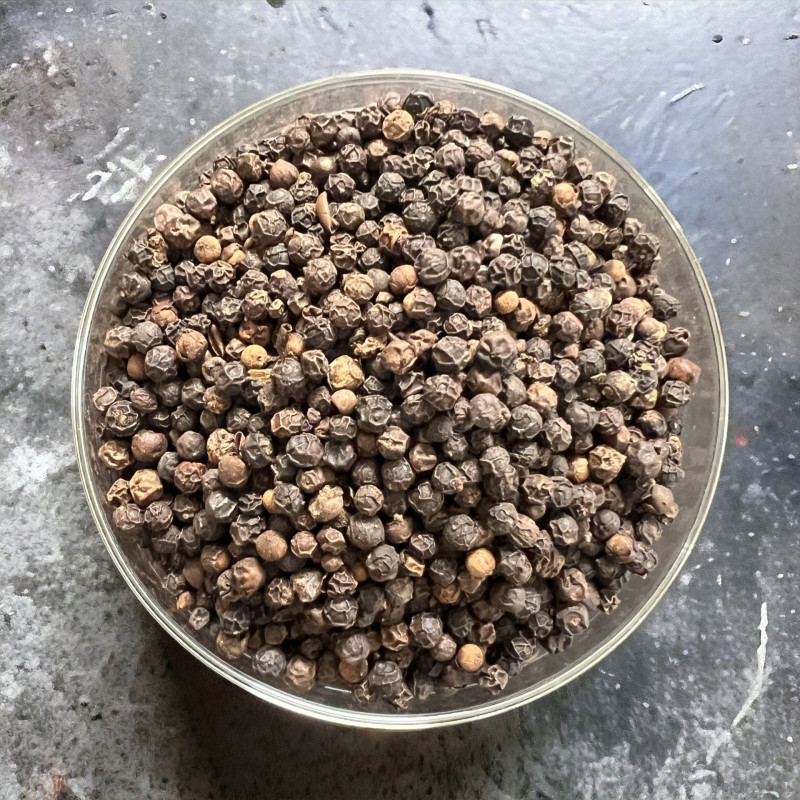
Reference: 6N745801


On the nose, it is peppery and fruity, and on the palate, it is powerful and fiery! It will please those who enjoy strong peppers!
It should be ground over all your dishes, enhancing them with its robust flavor!
 Delivery
Delivery
Mondial Relay
 Returns
Returns
See conditions
 Payments
Payments
100% secure
Livré en sachet refermable
Uses in Cooking:
On the nose, it is powerful and fruity at the same time. On the palate, it is fiery and has a long-lasting finish. Its grains are dark brown, very wrinkled, and relatively small.
It will particularly appeal to those who appreciate peppers with presence, strength, and a persistent flavor. To allow it to develop its full power, it must be ground in a mill or crushed in a mortar.
Who am I?
Origin: Madagascar
Scientific name: Piper nigrum
Black, white, and green peppers are all from the same fruit but at different stages of ripeness, produced by an exotic vine, the pepper plant, which only begins to bear fruit after 7 to 8 years of growth.
Piper nigrum, as the scientific name for true pepper, produces in order of maturity: first green pepper, then black pepper, and finally white pepper.
Green pepper is picked first, well before maturity. It is preserved in brine or dried. It is strong and pungent, similar to black pepper, as both retain their skin.
Black pepper is picked when slightly more mature, but still before full ripeness; it is reddish in color, and drying turns it black and wrinkles its skin. This skin gives it its strong and pungent flavor. It is the most widely used pepper in the world and is known to pair well with almost all spices and dishes.
White pepper consists of fully ripe berries that are soaked to remove their skins and then dried until they turn white. It is considered to be less pungent than black pepper and has a finer taste. What is certain is that it differs from black pepper and has the advantage of not leaving black specks in white sauces.
The cultivation of pepper plants originated from the west coast of India (Malabar coast) in the state of Kerala and has spread to many other countries: Southeast Asia (Indonesia and Malaysia), Madagascar, and Brazil. Recently, Vietnam has become the largest global producer of pepper. There are as many different flavors of pepper as there are places where it is cultivated, similar to wine!
Only the fruits of Piper nigrum (traditional black, white, and green peppers), Piper cubeba (cubeb pepper), and Piper longum (long pepper) are typically allowed to be called "pepper."
Pepper owes its spicy flavor to amides of piperine.
A Little History:
In Greece, under Alexander the Great, pepper was already in use, as it was among the Romans in antiquity.
Due to their high price, pepper and other rare spices were used as currency after the Arab conquest of Alexandria in 642 CE. This is where the expression "to pay in cash" (derived from "spices") comes from!
The exorbitant price of pepper in the Middle Ages and Italy’s monopoly on its trade were among the reasons that motivated the Portuguese to find a sea route to India. After Vasco da Gama discovered this route in 1498, a treaty was signed granting the Portuguese exclusive rights to half the world, including India, from which peppers originate. A century later, they lost their monopoly to the Dutch (with their East India Company) and the English.
Data sheet
Specific References
Reference: 6N745801
Reference: poivrevoatsE
Reference: poivreNEMalabar
Reference: poivrevoatsE
Reference: poivreNEvietnam
Reference: SriLankaBlanc
Reference: poivreEbiosaotome
Reference: 208029701
Reference: poivresichuanE
Reference: 2N70996502
Reference: 508207101
Reference: 9N7644901
Reference: 1N7049301
Reference: 6N745801
Reference: 6L5609802
Reference: baieroseE
Reference: Kubebe

On the nose, it is peppery and fruity, and on the palate, it is powerful and fiery! It will please those who enjoy strong peppers!
It should be ground over all your dishes, enhancing them with its robust flavor!